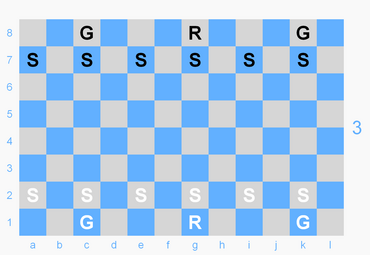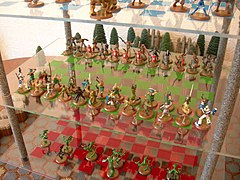 The Dragonchess 3D gameboard:
The Dragonchess 3D gameboard:
- Air (upper board)
- Land (middle board)
- Subterranean world (lower board)
 Gary Gygax
Gary Gygax
Dragonchess is a three-dimensional fantasy chess variant created by Gary Gygax, co-creator of the famed role-playing game Dungeons & Dragons. The game was introduced in 1985 in issue No. 100 of Dragon Magazine.
Boards and pieces
The Dragonchess gameboard consists of three 12×8 chess boards stacked vertically. The upper board (blue and white) represents the air, the middle board (green and amber) represents the land, and the lower board (red and brown) is the subterranean world (Gygax 1985:34).
The Dragonchess game pieces (42 per player) are an ensemble of characters and monsters inspired or derived from fantasy settings in Dungeons & Dragons. Intricate inter- and intra-level game piece capabilities are defined. As in chess, White moves first and then players take turns, and the game is won by delivering checkmate (inescapable attack) to the enemy king.
Upper board (level 3)


Sylph (S)
- On level 3:
- can move without capturing one step diagonally forward, or capture one step straight forward (i.e. like a Berolina pawn, but without promotion or an initial two-step option).
- can capture on the square directly below on level 2.
- On level 2:
- can move without capturing to the square directly above on level 3, or to one of the player's six Sylph starting squares.
Griffon (G)
- On level 3:
- can move and capture like a zebra, i.e. it can move two steps diagonally followed by one step orthogonally outward, jumping over any pieces in between.
- can move and capture to level 2, to a square diagonally adjacent to the square directly below (i.e. one step downward along a space diagonal).
- On level 2:
- can move and capture one step diagonally;
- can move and capture to level 3, to a square diagonally adjacent to the square directly above (i.e. one step upward along a space diagonal).
Dragon (R)
- on level 3, can move and capture either any number of squares diagonally or one step orthogonally (i.e. like a dragon horse in shogi, or a combined king and bishop from standard chess); it can never leave the upper board.
- can capture remotely (without leaving level 3) any piece that stands on the square directly below on level 2 or any square orthogonally adjacent to that square.
- it can only capture one piece at each turn, and the remote capture counts as a full move (i.e. the dragon may not move on level 3 and then capture remotely).
Middle board (level 2)


Warrior (W)
- on level 2, can move without capturing one step straight forward and capture one step diagonally (i.e. like a chess pawn but without the initial two-step option); it can never leave the middle board.
- promotes to a Hero upon reaching the furthest rank.
Oliphant (O)
- on level 2, can move and capture like a chess rook (i.e. any number of squares orthogonally); it can never leave the middle board.
Unicorn (U)
- on level 2, can move and capture like a chess knight (i.e. one step orthogonally followed by one step diagonally outward, jumping over any intermediate squares); it can never leave the middle board.
Hero (H)
- On level 2:
- can move and capture one or two steps diagonally (jumping over the intermediate square if moving two steps).
- can move and capture to levels 1 and 3, to a square diagonally adjacent to the square directly above or below (i.e. one step along a space diagonal).
- On levels 1 and 3:
- can only move and capture back to level 2, again to a square diagonally adjacent to the square directly above/below (i.e. one step along a space diagonal).
Thief (T)
- on level 2, can move and capture like a chess bishop (i.e. any number of squares diagonally); it can never leave the middle board.
Cleric (C)
- On any level:
- can move and capture one step orthogonally or diagonally (like a non-royal chess king).
- can move and capture to the square directly above or directly below on an adjacent level.
Mage (M)
- On level 2:
- can move and capture any number of steps orthogonally or diagonally (like a chess queen).
- On levels 1 and 3:
- can move one step orthogonally (like a wazir).
- On any level:
- can move and capture one step or two steps directly above or directly below to one of the other levels.
King (K)
- On level 2:
- can move and capture like a chess king (i.e. one step orthogonally or diagonally).
- can move and capture to the square directly below on level 1 or directly above on level 3.
- On levels 1 and 3:
- can only move back to the square directly above or below on level 2.
Paladin (P)
- On level 2:
- can move and capture as a chess king or as a chess knight.
- On levels 1 and 3:
- can move and capture like a chess king.
- On any level:
- can move to the other levels using a knight-like move: one level up or down followed by two steps orthogonally, or two levels up or down followed by one step orthogonally.
Lower board (level 1)


Dwarf (D)
- On levels 1 and 2:
- can move (without capturing) one step straight forward or sideways, or capture one step diagonally forward.
- can capture directly upward from level 1 to level 2, and move (without capturing) directly downward from level 2 back to level 1.
Basilisk (B)
- on level 1, can move and capture one step diagonally forward or straight forward, or move (without capturing) one step straight backward; it cannot leave the lower board.
- automatically freezes (immobilizes) an enemy piece on the square directly above on level 2 (whether the Basilisk moves to the space below or the enemy piece moves to the space above); the immobilised piece may not move until the Basilisk moves away or is captured.
Elemental (E)
- On level 1:
- can move and capture one or two steps orthogonally;
- can move (without capturing) one step diagonally;
- can capture in the following pattern: one step orthogonally, followed by one step straight upward to level 2.
- On level 2:
- can move and capture in the following pattern: one step directly downward to level 1, followed by one step orthogonally.
Move notation
Recording moves is done the same as in algebraic notation for chess, extended to a 12×8 board, with the addition of a numeric prefix (1, 2, or 3) in front of each square coordinate to identify the level. So for example, White's Elemental starts on square 1g1 (level 1, square g1); Black's King starts on 2g8; and so on.
Notes
- ^ Gygax does not mention whether this applies to only non-capturing moves, or to moves and captures.
- ^ Gygax does not mention whether the piece can jump over the intermediate square or not when making this move.
- Gygax initially describes levels beginning with "1" for upper board in the first page of his article (Gygax 1985:34), but consistently uses "3" for upper board and "1" for lower board in the subsequent six pages for all move definitions, examples, and sample moves (Gygax 1985:35–40).
References
- Gygax (1985), pp. 34–40
- Pritchard (1994), p. 95
- Pritchard (2007), p. 232
Bibliography
- Gygax, Gary (August 1985). "Dragonchess". Dragon Magazine No. 100. Vol. X, no. 3. TSR, Inc. ISSN 0279-6848.
- Pritchard, D. B. (1994). "Dragonchess". The Encyclopedia of Chess Variants. Games & Puzzles Publications. ISBN 0-9524142-0-1.
- Pritchard, D. B. (2007). "Dragonchess ". In Beasley, John (ed.). The Classified Encyclopedia of Chess Variants. John Beasley. ISBN 978-0-9555168-0-1.
External links
- Dragonchess by Edward Jackman, The Chess Variant Pages
- More on Dragonchess by Hans Bodlaender, The Chess Variant Pages
- Dragonchess at BoardGameGeek
- Dragonchess a simple program by Ed Friedlander (Java)
| Chess variants (list) | |||||||||
|---|---|---|---|---|---|---|---|---|---|
| Orthodox rules |
| ||||||||
| Unorthodox rules with traditional pieces |
| ||||||||
| Unorthodox rules using non-traditional pieces |
| ||||||||
| Multiplayer | |||||||||
| Inspired games | |||||||||
| Chess-related games |
| ||||||||
| Software | |||||||||
| Related | |||||||||